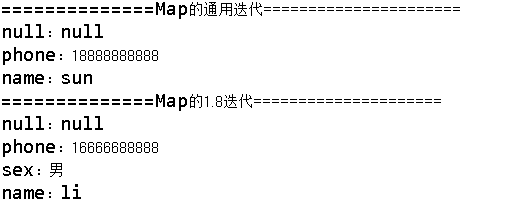Map接口中的forEach方法,@since 1.8
复制代码
1
2
3
4
5
6
7
8
9
10
11
12
13
14
15
16default void forEach(BiConsumer<? super K, ? super V> action) { Objects.requireNonNull(action); for (Map.Entry<K, V> entry : entrySet()) { K k; V v; try { k = entry.getKey(); v = entry.getValue(); } catch(IllegalStateException ise) { // this usually means the entry is no longer in the map. throw new ConcurrentModificationException(ise); } action.accept(k, v); } }
官方解释
复制代码
1
2
3
4
5
6
7
8
9
10
11
12
13
14
15
16
17
18
19
20
21
22
23
24
25
26
27
28/** * Performs the given action for each entry in this map until all entries * have been processed or the action throws an exception. Unless * otherwise specified by the implementing class, actions are performed in * the order of entry set iteration (if an iteration order is specified.) * Exceptions thrown by the action are relayed to the caller. * * @implSpec * The default implementation is equivalent to, for this {@code map}: * <pre> {@code * for (Map.Entry<K, V> entry : map.entrySet()) * action.accept(entry.getKey(), entry.getValue()); * }</pre> * * The default implementation makes no guarantees about synchronization * or atomicity properties of this method. Any implementation providing * atomicity guarantees must override this method and document its * concurrency properties. * * @param action The action to be performed for each entry * @throws NullPointerException if the specified action is null * @throws ConcurrentModificationException if an entry is found to be * removed during iteration * @since 1.8 */
翻译
复制代码
1
2
3
4
5
6
7
8
9
10
11
12
13
14
15
16对该映射中的每个条目执行给定的操作,直到处理完所有条目或该操作引发异常为止。除非实现类另有指定,否则操作将按条目集迭代的顺序执行(如果指定了迭代顺序)。操作引发的异常将转发给调用方。 * *@implSpec公司 *对于这个{@code map},默认实现相当于: *<pre>{@代码 *for(Map.Entry<K,V>Entry:Map.entrySet()) *action.accept(entry.getKey(),entry.getValue()); *}</pre> * *默认实现不保证此方法的同步性或原子性属性。任何提供原子性保证的实现都必须重写此方法并记录其并发属性。 * *@param action为每个条目执行的操作 *如果指定的操作为null,@throws NullPointerException *如果在迭代过程中发现某个条目被删除,@抛出ConcurrentModificationException *@自1.8
使用方法
复制代码
1
2
3
4
5
6
7
8
9
10
11
12
13
14
15
16
17
18
19
20
21
22
23
24
25
26
27
28
29
30
31
32
33
34package test_0; import java.util.HashMap; import java.util.Map; /** * @className: Map_1_8.java * @description: TODO map在JDK1.8之后与之前的不同应用 * @author: LiXiangyu * @date: 2021年7月23日 **/ public class Map_1_8 { public static void main(String[] args) { // TODO Auto-generated method stub Map<Object, Object> map = new HashMap<>(); map.put("name", "sun"); map.put("phone", "18888888888"); map.put(null, null); // 通用的Map迭代方式 System.out.println("==============Map的通用迭代======================"); for (Map.Entry<Object, Object> entry : map.entrySet()) { System.out.println(entry.getKey() + ":" + entry.getValue()); } System.out.println("==============Map的1.8迭代====================="); Map<Object, Object> map8 = new HashMap<>(); map8.put(null, null); map8.put("phone", "16666688888"); map8.put("sex", "男"); map8.put("name", "li"); // JDK8的迭代方式 map8.forEach((key, value) -> { System.out.println(key + ":" + value); }); } }
结果

注:list中forEach不推荐add/remove
在迭代时使用add/remove易出bug。推荐使用Iterator进行迭代,操作list进行add/remove
最后
以上就是风趣电灯胆最近收集整理的关于Map中的forEach方法的使用注:list中forEach不推荐add/remove的全部内容,更多相关Map中内容请搜索靠谱客的其他文章。
本图文内容来源于网友提供,作为学习参考使用,或来自网络收集整理,版权属于原作者所有。








发表评论 取消回复